Dryanovo area information
Dryanovo Properties Dryanovo municipality is located in the central part of the region over 248.5 sq km rugged terrain at an altitude of 180 to 640 m where beautiful mountain slopes are covered with mixed deciduous forests, and hills, rocks and rivers Yantra and Dryanovska.
Dryanovo municipality is located in the central part of the region over 248.5 sq km rugged terrain at an altitude of 180 to 640 m where beautiful mountain slopes are covered with mixed deciduous forests, and hills, rocks and rivers Yantra and Dryanovska.The climate is temperate continental with mild winters and cool summers, very favorable all year round for recreation and tourism. The municipality is located in the administrative district of Gabrovo.
In the municipality are located the town of Dryanovo and 62 smaller settlements. The townis easily accessible by major links from North and South Bulgaria: railway line Ruse - Podkova and highway Ruse - Stara Zagora.
Dryanovo is located 22 km from Gabrovo and its ethnographic complexes, 24 km from the medieval Bulgarian capital Veliko Tarnovo, 17 km from Tryavna and 34 km from Sevlievo – the old Hotalich.
The population of the municipality is about 11,000 inhabitants. In the area around Dryanovo were found some of the oldest traces of life on the Balkan Peninsula - in the cave "Bacho Kiro". The second Bulgarian kingdom is inextricably linked to Dryanovo region. Since that time were the remains of the medieval fortresses "Gradat", "Boruna", "LipovoGradishte" and others.
Draynovo was founded in 1470 , but close to the city was another settlement during the XI - XII century.
Cave "Bacho Kiro"
Cave "Bacho Kiro" is located near Dryanovski Monastery in the canyons of Andaka River and Dryanovska river. It is 300 meters from the monastery "St. Archangel Michael" in a vertical limestone cliff 25 meters high and 335 meters above sea level.It was the first electrified cave in Bulgaria by the tourists in Dryanovo in 1937, and received its name in 1940 in honor of the hero of the April Uprising- Bacho Kiro.
In 1962 it was declared a natural landmark.
The cave complex is a four storey labyrinth of caves and galleries around 3600 m.For visitors it was createdan electrified part of 700 m. It was formed in three main directions- east, northeast and southeast of underground rivers in thick limestone rocks, formed on the bottom of a warm sea. Geomorphological studies give reason to assume that the layout was formed for about 1800000 years. Its formation is closely linked to the development of the river valley and tributary had Dryanovska river and its additional source of water - Andaka river.
Over time, rivers formed cave galleries and halls, this happened within the younger Tertiary and Quaternary. This is the initial stage of formation of the cave. From there begins the secondary formation by the artistic karst waters. Tireless drops of water enriched with lime substance for hundreds of thousands of years that gradually formedthe beautiful cave stalactites, stalagmites, lent their most bizarre forms.
The impressive lighting offers to visitors the opportunity to see the fantastic formations of nature, given names accordingly: Rain Hall, Stone Flower, Poplar, Lake of happiness, Concert Hall, The Entrée, Jellyfish, Bear slide, Meadow, The Lonely Stalactone, Hall of Father Hariton, Elephant cave ear, Purgatory, Throne, caves Eagle Reception Hall with hundreds of shapes and formations.
Cave "Bacho Kiro" is an archaeological site of national importance. The cave is one of the 100 national tourist sites under № 22. It is managed by its first development in 1937 until now by the Tourist Association "Bacho Kiro" Dryanovo.
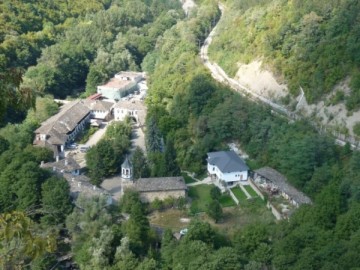 Drjanovski Monastery "St. Archangel Michael"
Drjanovski Monastery "St. Archangel Michael"Have you ever had to go somewhere and not be able to enjoy the view with which you are surrounded?
This wilderness welcomes warmly all tourists decided to visit Dryanovski monastery.
For nine centuries Drjanovski monastery withstands the vicissitudes of fate. Three times it was destroyed and burned and three times patriotic Christians restored it to continue to fulfill its role as a stronghold of the Bulgarian spirit. The fabulous monastery gorge has an ancient history. The first people settled in the early prehistoric periods. They inhabit caves array Boruna and cavities in the rock Polichkite.
The monastery was founded in the reign of Tsar Kaloyan, after transporting the relics of St. Michael Soldier of Potuka to Tarnovo (1197-1207). The procession spend the night near the river Dryanovska near the Fortress “Grada” and according to the Christian canons on the holy place has to be built a monastery. The initial location is 2 km north from the present, in the region called "Malki St. Archangel", opposite the cave "Andaka ". In the 14th century the monastery became one of the main centers of Hesychasm and sheltered many monks, which required a new extension. But in 1393 the Turks besieged Tarnovo and destroyed everything in their way,didn`t spared the monastery and it burned to the ground. In the 16th century patriotic Bulgarians from the region again restored the monastery. This time they chose another location - in the area "Great Archangel" on the opposite bank of the river, but the fate of this monastery is the same. And now it is at the current location of where it was built at the end of the 17th century. Gradually the monastery resumes its rightful place in the spiritual and cultural life of the Bulgarian lands. It has a huge library. The monastery became one of the largest centers of scholarship during the Renaissance. A writing copy from the Hilendar Monastery in Athon shows that at that time it had about 500 monks. His fame rests in all parts of the Balkan Peninsula, but this did not prevent it to burn for a third time.
The boom and prosperity of the monastery began in the time of Archimandrite Raphael - abbot of the monastery, who started renovation of the monastery in the 40s of the 19th century. Residential buildings were built along the river, and in 1845 was completed the new temple. So the monastery already has two churches and five additional buildings. The writing and literary activities of the monks was restored too. At that time the abbot changed and the new - the monk Pahomii Stoyanov, continued the work of his predecessor, but actively involved in the preparation of the April Uprising. He together with Vasil Levski, Matey Preobrajenski - Mitkaloto and Dryanovski Revolutionary Committee established a solid base for support the fighting troops in Northern Bulgaria. Storehouses were built where they gathered food and weapons for the rebels. On April 29, 1876 in the monastery came the troop of Pop Hariton and Bacho Kiro - the first rebel group for Veliko Tarnovo and Bulgaria. But Turkish troops observed and besieged them. Nine days continued the heroic resistance of the 195 rebels to the 5 000 strong Turkish army. Only 47 of the rebels managed to escape, the others died there. The monastery was completely destroyed. They have burned the entire monastery library. The destroyed and burned monastery was partially reconstructed and on April 3, 1877 its main temple was officially opened. The abbot Pahomii Stoyanov held the first memorial service for the dead warriors. The temple has no murals with Turkish bullet pierced chalice and Turkish shrapnel holes in the walls, which were deliberately left to not forget the past and Bulgarian suffering.
The site of a small church was built mausoleum representing chapel charnel house and a statue of a revolutionary. Gradually, the Dryanovo monastery became a religious and cultural center and one of the largest and well-kept abodes in Turnovo region. The present monastery is one of the ten most revered shrines of the Bulgarian Orthodox Church, a national monument and the starting point for many hiking trails.
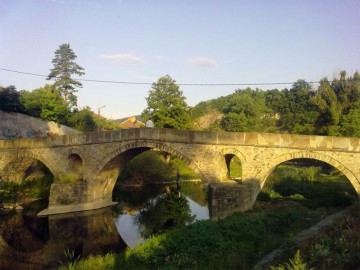 The bridge over the Dryanovska River
The bridge over the Dryanovska RiverThe bridge is a monument of Koliu Fitcheto in the mid-nineteenth century. The facility was an early master of hydraulic structures, which develop their ideas for the traditional type of revival "humpback" (Roman) bridge. Its length is 38.50 m and the width is 5 meters. The bridge has four arches with different sized holes, standing on three massive stone columns. Most - the second highest arch bridge over which canvas is slightly hunched. The bridge columns are with arched openings and cutwater for skipping high water. The flooring of the bridge is a large cobblestones and sidewalks - plates that go over the blocks of the arches and parapet to form a cornice and emphasize the curve of the sail. The shape of all arches and vaults opened is highlighted with a cornice.
Eco trails
Dryanovska trail
Built in 2000.
/Wooden bridges and stairs are now impassable/
Paths near the rock "Boruna" create opportunities for visitors to experience the untouched nature.
Here you can enjoy rare rock formations raise your adrenaline and to see rare plants from the Bulgarian fauna. There are three astronomical sites of rock “Boruna" from which there is a beautiful view of the area of Dryanovski monastery.
The walk takes two hours.
Ecopath "Via Ferrata" - Dryanovski Monastery
Built in 2003.
The trail goes from the monastery near the railway line along the river Dryanovska, ends "Sini Vir" in stone and iron stairs to the edge of the rock to the east of the monastery, on a rocky path to the plateau "Strinava"/fortresses "Gradat" and "Chukata"/ descending through the woods near the monastery vineyard and ends in the parking lot in front of the monastery.
The route offers an incredible panorama towards Dryanovski Monastery Dryanovo. Visitors meet with diverse flora and fauna.
The walk lasts two hours.
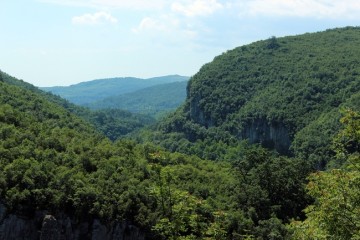 Ecopath "From Diskoduratera to nowadays"
Ecopath "From Diskoduratera to nowadays"2 km south from Gostilitsa the Yantra river forms a small fertile valley, surrounded on all sides by corrugated hills. Here between the mouths of two small flows - Uzunovo plain and Malkoyalarska river are the ruins of the old Roman fortress "Diskoduratera" whose name means "double strong fortress". Built and settled in the second half of the second century, it was founded during the reign of Emperor Marcus Aurelius citizens Augusta Traiana and ordinary road station has become one of the main markets in the Lower Danube provinces. During the third century Diskoduratera was destroyed by the Goths and was later restored to reach its zenith in the 5-6 age at the coming of the Slavs. During the archaeological excavations were discovered walls, towers, buildings, and other findings. Ecopath "From Diskoduratera to nowadays" offers an exciting experience, combining beautiful scenery and historical landmarks. The eco trail is 3 kilometers long and final destination - the foot of the ancient fortress Diskoduratera. Diskoduratera is part of an ancient trade route to Asia Minor, starting from Nikopolis Istrum (the ruins are located in the village Nikyup, 20 km north of Veliko Turnovo), passing through the castle to Augusta Traiana (now Stara Zagora) and Constantinople. In the transition are observed typical Balkan Mountains flora and fauna. The trail runs along the old Roman road, near which is the ritual mound - Yurta. The trail is equipped with recreation and drinking water fountain.
History
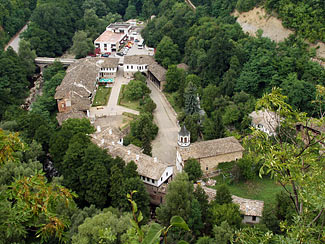 In region of Dryanovo were found the oldest traces of life on the Balkan Peninsula - in Bacho Kiro Dryanovo near the Dryanovo monastery situated in the valley of the River Andaka was found evidence of human habitation from the Paleolithic. There are numerous remains of ancient villages, castles, columns with inscriptions and ornaments of the Thracians and Romans (Fortress "Boruna" and "Diskoduratera"). The cave has several levels with a length of about 3 km.
In region of Dryanovo were found the oldest traces of life on the Balkan Peninsula - in Bacho Kiro Dryanovo near the Dryanovo monastery situated in the valley of the River Andaka was found evidence of human habitation from the Paleolithic. There are numerous remains of ancient villages, castles, columns with inscriptions and ornaments of the Thracians and Romans (Fortress "Boruna" and "Diskoduratera"). The cave has several levels with a length of about 3 km.The background of Dryanovo can definitely be looking in Thracian and Roman times. Settlements are rare in our country, which are surrounded by so many forts and settlements. The remains of these castles near Dryanovo, 2000 years ago, are an eloquent witness to the past of this region.
One of these forts around the town is "Diskoduratera". It was built by the Romans between the current village Gostilitsa and Dryanovo in 176-180 AD. This fortress built on the border of the Roman provinces of Thrace and Mizia, was founded during the reign of Emperor Marcus Aurelius (161-180 AD) by the citizens of Augusta Traiana (Stara Zagora) and from being just an ordinary roadside station, became one of the main markets in the Lower Danube provinces. In the middle of the third century Diskoduratere was destroyed by the Goths. It was later restored and reached its zenith in the V and VI century. Then life interrupted and resumed during the Second Bulgarian Kingdom, as medieval and convenient station for the night near the capital Tarnovo.
But before the Romans, the Thracians liked the local places. They also built their forts and settlements around today Dryanovo. In the plateau "Orlovo gnezdo", which is 3-4 km southwest of the city can be seen the remains of an ancient fortress. The area is naturally fortified on three sides by sheer cliffs, and the fourth side was surrounded by a high stone wall.
There was a large building was probably the palace of the kings of the family Asenevtsi. The castle served as a major foothold against the invasions of barbarian tribes beyond the Danube. It was used by the Thracians, and after them the Romans and the Byzantines, then by the Slavs and Prebulgarians. Here in 1190 was defeated the numerous army of the Byzantine Emperor Isaac II Angelos.
During the Ottoman rule Dryanovo manages to keep the Bulgarian spirit and the Dryanovski monastery is one of the major Bulgarian guardians of faith, writing, traditions, culture. The population here enjoys certain tax benefits as for years they have been dervendjii-guardians (guardians of the pass). However, this does not make their lives much easier because they were constantly harassed by many local landlords, when they have complained even to the Sultan and sent to him numerous letters to him personally.
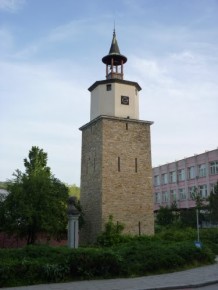 In 1779 in the center of Veliko Tarnovo was built a clock tower. This was necessary because of the development of crafts and the need to know the exact time. At that time, the presence of a clock tower was a sign of a developed village and Dryanovo is one of the first. Unfortunately the clock tower was destroyed twice - once by the Ottomans and by the Communist government. Stubborn Dryanovo however allowed to lose one of the symbols of the city in 1984 and restored it to its present-day appearance, which is quite close to the original.
In 1779 in the center of Veliko Tarnovo was built a clock tower. This was necessary because of the development of crafts and the need to know the exact time. At that time, the presence of a clock tower was a sign of a developed village and Dryanovo is one of the first. Unfortunately the clock tower was destroyed twice - once by the Ottomans and by the Communist government. Stubborn Dryanovo however allowed to lose one of the symbols of the city in 1984 and restored it to its present-day appearance, which is quite close to the original.Must mention the name of Maxim Rajkovic, who gives great resistance to the Greek Phanariot in Turnovo and his whole life, was dedicated to the preservation of Bulgarian culture and spirituality of teaching and donating money to several Bulgarian schools. Part of his will he gives to build a school in his native town Dryanovo which should unite three existing schools in the city – one in every neighborhood. It has to be noted that in all three has always been taught in Bulgarian, there was no Greek influence, which was very popular at that time elsewhere.
Dryanovo actively participated in the April Uprising of 1876. For nine days in Dryanovski monastery was held a battle of rebels Bacho Kiro and Pop Hariton against the numerous Turkish army. It`s liberation Drianovo gets on July 12, 1877.
After the liberation of the municipality occur several large factories: the tobacco factory of brothers Shishkovi (in 1896 ranks first in terms of output and profit among the ten tobacco factories in the county), candy factory Mutafchievi brothers, joint-stock company "Zdravina" transformed into the First Bulgarian wagon factory.
1907 began the construction of sewers in the city and in 1927 Drianovo already was supplied with electricity.
In 1930 Drianovo was declared a mountain resort.
Dryanovo Properties

